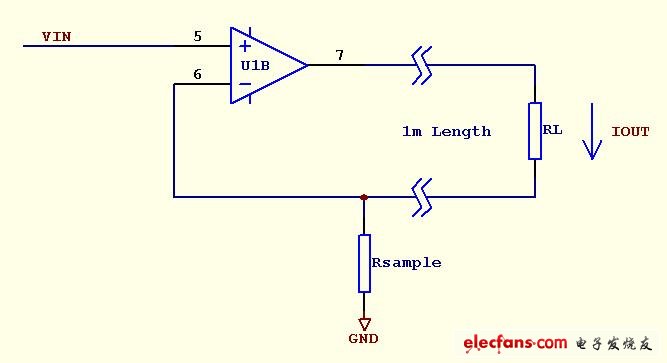Current source design small Tips (1): How to choose the right op amp
For engineers, the current source is an indispensable instrument, and many people want to make a common current source. The application of the open source kit is just a set of PCB, components, programs and other complete sets of products. Participants only need to The kit's things are soldered well, and debugging can be done. How much technical content can be used here, and how much technology can we learn from it? This article is only from the principle of telling, to guide everyone to do the current source that individual can control. This article is mainly to design the content of the simulation part, and basically does not involve the single-chip microcomputer, I hope that friends can learn from the knowledge.
My goal this time is to build a 20V/100mA current source with basic functions, which can fix the output and can be stepped by the microcontroller. The figure below is a DC current source that is easy to implement with digital control. Assume that the op amp has an ideal output capability. If the output current is 100 mA, what is the value of the sampling resistor Rsample?

figure 1
If Rsample is too large, it will result in:
1. The sampling power is too high, and the Rsample temperature stability requirement is high, so the cost increases exponentially.
Explanation: If Rsample=1 Ohm, Vsample=1V, Psample=100mW, for precision applications, resistance dissipation of 100mW is usually an unacceptable sampling power.
2. The voltage dynamic range on the RL is reduced, reducing the upper limit of the RL resistance.
However, the requirements for op amps and Vin conditioning circuits are correspondingly reduced.
If Rsample is too small, it will cause various errors in the op amp:
1. VOS drift is comparable to Vin, causing output current error.
Explanation: Rsample=0.1 Ohm, Vsample=10mV, if LM324 is used, VOSmax=3mV, potential DC error is 30%; VOS/dTmax=30uV/C, 10C temperature change causes potential error 3%.
2. The circuit gain is too high, the op amp noise is amplified, and the voltage on RL is basically unchanged, causing the voltage noise on the RL to increase, resulting in an increase in current noise on the RL.
3. The requirements for op amps have increased and the cost has increased linearly.
4. Increased requirements for conditioning circuits that handle Vin, thereby increasing costs.
However, the requirements for Rsample are correspondingly reduced.
About how to choose the sampling resistor:
The current source needs to sample the current for feedback. Although there are other methods to sample, the most stable and accurate method is still the resistance sampling.
Popular knowledge: The resistance power used for sampling is at least 20 times higher than the sampling power, so as not to cause significant drift due to heat generation.
Last time, the current of 100mA_ is a very common current value, but it is usually a relatively sturdy current value for resistance sampling.
The current of the A_ class usually does not require too high accuracy, and the shunt sampling is dominant, as long as the power is sufficient.
The current of the mA/10mA_ stage is relatively simple, and since it does not generate significant sampling power, the usual precision metal film resistors can meet the requirements.
The current of the 100mA_ class is not too big, and the shunt does not have such a large resistance. The precision metal film resistor does not have such a large power.

figure 2
Solution:
1. Reduce the sampling voltage and use a small resistance
2. Reduce the sampling power. Under the same power, the resistance should be as large as possible.
Seemingly contradictory, in fact very simple, parallel multiple precision metal film resistors.
Example:
100mA, sampling resistor 4 only 12 Ohm 0.1% 1/4W 25ppmmax metal film resistors in parallel, equivalent resistance 3 Ohm, sampling voltage 300mV, sampling total power 30mW, each resistor power 7.5mW.
This method requires more work on the PCB, and it must be borne in mind that copper also has resistance, and copper itself can be used as a temperature sensor.
Usually 0.1% accuracy is not necessary, but the temperature drift must be small. However, the accuracy and drift of the actual resistance products are basically corresponding. When buying the resistor, it must be inquired in addition to the power.
In addition, the resistors are best aged before leaving the factory, and the aging-free resistors are usually cheaper, but the performance will vary somewhat within a few days after power-on.
This cost:
12 Ohm 0.1% 1/4W 25ppmmax metal film resistor 4 unit price of 0.50 yuan, a total of 2.00 yuan.
Bulkhead Lamp,Led Bulkhead Lamp,Round Bulkhead Light,Bulkhead Ceiling Light
Changxing Fanya Lighting Co.,Ltd , https://www.fyledlights.com